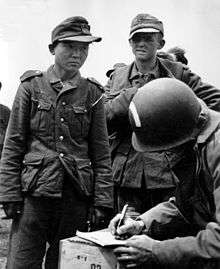Yang Kyoungjong
Yang Kyoungjong (Korean: 양경종) is the name of a supposed Korean soldier who, according to historians, fought in the Imperial Japanese Army, the Soviet Red Army, and later the German Wehrmacht during World War II.[1] He is, to date, the only soldier in recent history thought to have fought on three sides of a war, and this status has earned him recognition.[2] Although both popular news outlets and several historians have regarded this as a fact, a Korean documentary said there was no clear evidence of his existence.
Yang Kyoungjong | |
|---|---|
 | |
| Born | March 3, 1920 Heijō, Japanese Korea, Empire of Japan (modern-day North Korea) |
| Died | 1992 (aged 71–72) Illinois, United States |
| Allegiance | |
| Service/ | |
| Years of service |
|
| Battles/wars | |
| Korean name | |
| Hangul | 양경종 |
| Revised Romanization | Yang Gyeong-jong |
| McCune–Reischauer | Yang Kyŏng-chong |
| Japanese name | |
| Kana | ヤン・キョンジョン |
| Romanization | Yan Kyonjon |
| Russian name | |
| Russian | Ян Кёнджон |
| Romanization | Yan Kyondzhon |
World War II
In 1938, at the age of 18, he was in Manchuria when he was conscripted into the Kwantung Army of the Imperial Japanese Army to fight against the Soviet Union.[1] At the time, Korea was ruled by Japan.
During the Battle of Khalkhin Gol, he was captured by the Soviet Red Army and sent to a Gulag labor camp.[3]
Because of Soviet manpower shortages in the fight against Nazi Germany, he was pressed, in 1942, into fighting in the Red Army, along with thousands of other prisoners. He was sent to the Eastern Front of Europe.[3]
In 1943, he was captured by Wehrmacht soldiers in eastern Ukraine during the Third Battle of Kharkov, and then joined the "Eastern Battalions" to fight for Germany.[3] Yang was sent to Occupied France to serve in a battalion of former Soviet prisoners of war on the Cotentin peninsula in Normandy, close to Utah Beach. After the D-Day landings in northern France by the Allied forces, Yang was captured by paratroopers of the United States Army in June 1944.
The Americans initially believed him to be a Japanese soldier in German uniform; at the time, Lieutenant Robert Brewer of the 506th Parachute Infantry Regiment, 101st Airborne Division, reported that his regiment had captured four Asians in German uniform after the Utah Beach landings, and that initially no one was able to communicate with them. Yang was sent to a prison camp in Britain and later transferred to a camp in the United States.
Later life
Allegedly, Yang Kyoungjong, a German prisoner-of-war, was released by the US Army from captivity in 1947.[4] He became a US citizen[3] and moved to Illinois, United States, where he lived until his death, in 1992.[4]
Identification
After the invasion of Normandy on D-Day, a photo was taken of an unidentified man in Wehrmacht attire being processed as a prisoner of war. The official caption does not give his name, and instead refers to him as "young Japanese".[4] The current description on the US National Archives refers to him as a "young Japanese man".[5]
The identity of the man has been a source of speculation, and in the 1990s a theory emerged that he was a Korean who was captured by the USSR, who was then captured by Nazi Germany and pressed into service. Then later the man was identified as Yang Kyoungjong, however, no direct proof of this has been found.[4] Author Martin Morgan believes the man is not Yang Kyoungjong, but instead an ethnic Georgian from the 795th Georgian Battalion, which was composed of Georgian Osttruppen troops.[4]
In December 2005, the Seoul Broadcasting System aired a documentary on the existence of the Asian soldiers who served Nazi Germany and were captured by Allied forces. The documentary concluded that although there had been Asian soldiers in the German Army during World War II, there was no clear evidence for the existence of Yang Kyoungjong.[6]
Legacy
The story of Yang was the basis for the 2011 South Korean film My Way.
In 2018, a city councillor in St. John's, Newfoundland, used the story of Yang as the basis for an online ad promoting her real estate business, which caused backlash.[1]
See also
- Lauri Törni
- Joseph Beyrle
- Aleksandr Pavlovich Min
- Ivor Thord-Gray
- Apolonio de Carvalho
References
- Breen, Katie (June 18, 2018). "Debbie Hanlon faces criticism for real estate ads featuring prisoner of war". CBC. Retrieved June 18, 2018.
- Antony Beevor, (2012). The Second World War. Weidenfeld & Nicolson. ISBN 0297860704
- Zaloga, Steven (October 1, 2013). The Devil's Garden: Rommel's Desperate Defense of Omaha Beach on D-Day. Stackpole Books. p. 60. ISBN 978-0-8117-1228-6.
- A., Morgan; K., Martin (May 15, 2014). The Americans on D-Day : a photographic history of the normandy invasion. Minneapolis, MN. p. 135. ISBN 9781627881548. OCLC 874563481.
- United States Department of Transportation. United States Coast Guard. Office of Public and International Affairs. 4/1/1967-1985 (1944). Dismay and loneliness is written on the face of this young Japanese man, wearing a Nazi uniform, in a roundup of German prisoners on the beaches of France. The Japanese man is giving his name and number to an American Army captain. Series: Activities, Facilities, and Personalities, 1785 - 2005.
- "다시보기 : SBS 스페셜". wizard2.sbs.co.kr (in Korean). Archived from the original on March 4, 2016. Retrieved June 6, 2016.